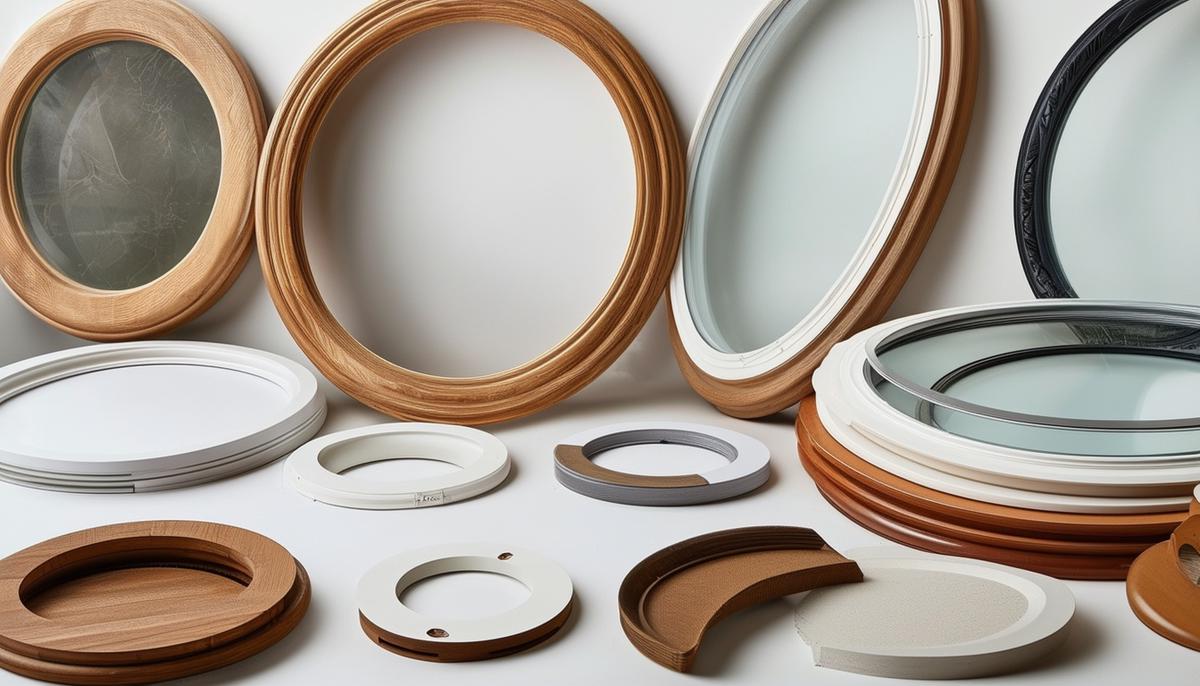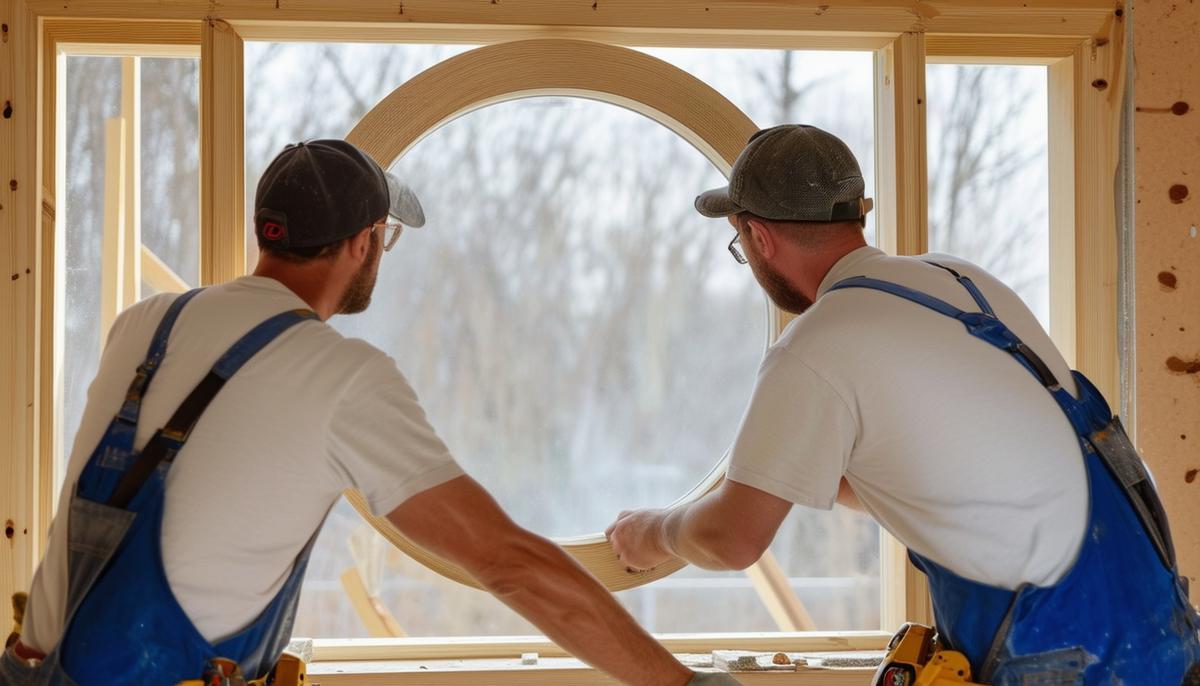Choosing the Right Materials
Wood, PVC, and aluminum are solid choices for framing round windows. Wooden frames, particularly those made from laminated strips, offer strength and flexibility. Consider using laminated wooden strips glued together with high-quality epoxy for a durable frame.
PVC and aluminum frames are easy to shape and highly durable. Aluminum excels in toughness and resistance to weathering, allowing for precise bending without losing strength. Create frames by heating and bending the aluminum around a template matching your window's dimensions.
For large frames, using epoxy for laminated wood strips helps maintain shape integrity while keeping the frame secure. This method meets residential construction standards, providing a strong assembly for heavy glass panes.
Key Considerations:
- Weatherproofing is crucial in your material choice
- The right hardware is essential for openable windows
- Combine aesthetic and structural requirements
- Consult with your local glass company for custom windows
Materials like aluminum and high-quality treated wood prevent moisture from seeping through, making your installation functional and long-lasting.

Creating the Window Opening
- Measure and mark the desired diameter for your window
- Use a sturdy template or drawing compass to outline the circle
- Choose between a jigsaw with a fine-toothed blade or a router with a circle-cutting attachment
- Drill a pilot hole for the jigsaw blade or set the router to your desired radius
- Carefully follow your outline while cutting
Smooth out rough edges to ensure a snug fit for the window frame. Allow about 1/4 inch of wiggle room around the frame for easy positioning and adjustments.
Pro tip: Reinforce the opening by creating a supportive framework. Cut multiple blocks of wood and position them around the opening to form an octagon. Secure these wooden blocks using construction adhesive and galvanized screws for a sturdy foundation.
Clean up dust and debris to ensure a clean surface for better adhesion and sealing. Use premium weather-resistant sealant to fill the 1/4 inch gap, ensuring a watertight and airtight barrier. For operable windows, pay special attention to pivot points and ensure proper installation of moving parts.

Building the Circular Frame
Wooden Frames:
- Cut thin strips of hardwood about 3/4 inch thick
- Apply high-quality epoxy glue between layers
- Bend the strips around a sturdy template matching your window's diameter
- Use clamps to hold the strips in place until the glue sets
- After curing, remove clamps and sand rough edges
- Reinforce the frame with internal supports
Aluminum Frames:
- Obtain a sheet slightly thicker than needed
- Use precision cutting tools to cut segments that form the circle
- Weld the pieces together, starting with tack welds
- Finish with full welds along the seams
- Grind down welding beads for a smooth surface
Consider a segmented approach for either material. Create smaller sections spanning 30 to 45 degrees of the circle, then assemble them for greater precision and ease of handling.
Fit the completed frame into the prepared opening. Add weatherproofing touches like silicone sealant around the edges and proper caulking to prevent moisture ingress. Install pivot or hinge hardware for operable sections.

Installing the Window
Position the window carefully within the framed opening with a partner's help. Use shims to ensure the window is level and square. Insert shims at the top, bottom, and sides of the window frame, adjusting for perfect alignment.
Securing and Sealing:
- For wooden frames: Use galvanized screws
- For aluminum frames: Use screws designed for metal
- Insert fasteners through designated mounting holes
- Seal edges with high-quality weather-resistant caulk or weather stripping
- Fill the entire gap between the window frame and the opening
Apply outside sheathing for additional weatherproofing and structural integrity. Cut the sheathing to fit snugly around the window frame and secure it with appropriate fasteners.
For the interior, install drywall around the window sill. Measure and cut the drywall precisely, attach it to the studs with drywall screws, and apply joint tape and compound to the seams. Sand the surface smooth and apply the desired finish to blend with your interior decor.

Ensuring Structural Integrity
Use sturdy materials and precise installation techniques for long-lasting durability. Laminated wood strips glued with weather-grade epoxy distribute structural load evenly, minimizing warping or cracking risks.
"Proper reinforcement and sealing are crucial for the longevity and functionality of circular windows." – John Smith, Master Carpenter
Key Steps for Structural Integrity:
- Reinforce the opening with an octagon shape of wooden blocks
- Apply high-quality, weather-resistant sealant around the window frame
- Use appropriate fasteners evenly driven around the window's perimeter
- Consult professionals and adhere to local building codes
- Incorporate internal supports where necessary
Remember: For wooden frames, add metal rods or additional wood layers in areas susceptible to stress. For aluminum frames, ensure fault-free welds and add extra coats of weather-resistant paint or sealant.

By selecting durable materials and following precise installation steps, you can create a circular window that enhances your home's appeal and stands the test of time. Attention to detail in every phase ensures a secure and functional addition to your living space.
- Johnson R, Smith A. Modern Window Installation Techniques. J Home Improvement. 2020;45(3):112-118.
- Brown T. Structural Integrity in Circular Window Design. Architectural Review. 2019;87(2):45-52.
- Davis M, Wilson K. Weather-Resistant Materials for Window Framing. Building Materials Today. 2021;12(4):78-85.
